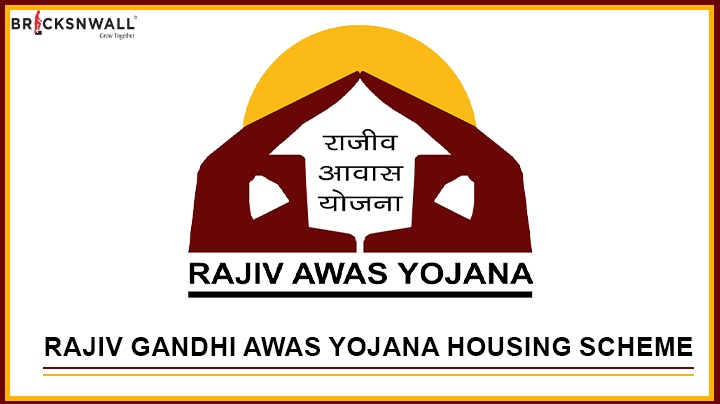Rajiv Awas Yojana (RAY)
Bricksnwall Trusted Experts

The "Rajiv Awas Yojana" was launched by
the Indian government and is being handled by the Ministry of Housing and Urban
Poverty Alleviation (MHUPA). This Central Sector Scheme directs the states and
union territories to grant property rights to slum dwellers and the urban poor
with the goal of establishing a slum-free India. In this post, let's examine
the Rajiv Awas Yojana in more detail.
The following are the goals of the Rajiv Awas Yojana (RAY):
- In
order to stop slums from expanding, it is necessary to offer basic
housing, municipal infrastructure, and social services to all slums—not
just those that have been notified.
- to
construct makeshift homes in slums and low-income areas with utilities
like water supply, internal and approach roads, sewerage, drainage, street
lighting, and social infrastructure amenities.
- To
make reforms that address the factors that contribute to the development
of slums possible.
- Establishing
a favorable atmosphere to enable the urban poor's institutional credit
connections to grow.
- To
create an atmosphere that is conducive to improving institutional credit
connections for urban poor people.
- To
create an atmosphere that is conducive to improving institutional credit
connections for urban poor people.
- Instituting
measures to stop the development of slums, such as the supply of cheap
housing.
- to
strengthen resource networks and undertake comprehensive capacity building
in order to increase institutional and human resource capacities at the
municipal, city, and state levels.
- To
strengthen and support slum dwellers' associations and federations in
order to ensure community participation in decision-making at all levels.
The Scheme's Applicability
- All
of the nation's cities and Urban Agglomerations (UAs) can use the plan.
According to the plan, the states will choose which people to ask for
help, after consulting with the center. The cities/UAs covered by the
Rajiv Awas Yojana's preparatory phase are automatically included in the
scheme's implementation phase.
- The
cities and UAs may also be chosen based on the following criteria:
- The
plan should give priority to the Cities/UAs with a high percentage of slum
people.
- Priority
should be given to the district headquarters and cities with significant
religious, cultural, historic, and tourism value.
- The
cities/UAs to be covered by the program include those where the majority
population consists of Scheduled Castes (SCs) and Scheduled Tribes (STs),
minorities, or other vulnerable groups.
- The
States and UTs will have to evaluate their own abilities to mobilize
resources and the availability of the monies allotted under this plan
before choosing cities.
- The
States and UTs will have to evaluate their own abilities to mobilize
resources and the availability of the monies allotted under this plan
before choosing cities.
- Whether
on lands/property owned by the Central Government or its undertakings,
autonomous bodies established under an Act of Parliament, State Government
or its undertakings, Urban Local Bodies (UBLs), or any other public agency
or private sector, the scheme is applicable to all slum areas within a
city, whether notified or non-notified (including the identified and recognized).
It also applies to urban homeless people and pavement dwellers, as well as
the "urbanized villages" that are part of the city's planning
area.
Quantity and Type of Financial Support
|
Category |
Type of City/Urban Agglomerations (UAs) as per
the Census |
Components |
Contribution of |
Beneficiaries |
|
||||
|
Centre |
State |
ULB |
|||||||
|
Category
A |
Cities/UAs
having 5 lakhs population and above |
Housing |
50% |
25% |
0 |
25% |
|||
|
Infrastructure |
50% |
25% |
25% |
0 |
|||||
|
Category
B |
Cities/UAs
with the population less than 5 lakhs |
Housing |
75% |
15% |
0 |
10% |
|||
|
Infrastructure |
75% |
15% |
10% |
0 |
|||||
|
Category
C |
Cities/UAs
that are in the North Eastern Region and special category States (Jammu &
Kashmir, Himachal Pradesh and Uttarakhand) |
Housing |
80% |
10% |
0 |
10% |
|||
|
Infrastructure |
80% |
10% |
10% |
0 |
|||||
Cities with a population above 5 lakhs will have a
maximum of 5 lakhs per Dwelling Unit (DU). This cap would be 4 lakhs per DU for
smaller cities, meaning that fewer than 5 lakh people live there. The highest
ceiling, regardless of the city's population, shall be set at 5 lakh per
dwelling unit in North East Regions and Special Category States. The cost of
necessary civic infrastructure and social facilities will also be included in
the upper ceilings, as previously mentioned. Per DU, the cost of social amenities
and municipal infrastructure cannot be more than 25% of the entire cost. Under
this arrangement, the Central Government funds will not cover the cost of the
land.
The ULB share would be replaced with money
available under the MPLAD/MLALAD. The State/UT may pay the ULB share or the
other way around.
Beneficiary contributions are necessary to foster a
sense of ownership among recipients. They must be made at least 10% in the case
of SC, ST, OBC, single women, PH, and other weaker and vulnerable groups, and
12% in the case of the general category.
Initiatives Supported by the Plan
The Central Government would additionally support
the following activities: 50% for cities with a population of more than 5
lakhs, 75% for cities with a population of less than 5 lakhs, and 80% for NER
and special category states. The state of Tamil Nadu has been given Rs. 480.14
lakhs under this RAY initiative to carry out the slum eradication project's
activities.
The CSMC shall decide on the unit cost or the financial standards for the activities mentioned below.
- The
creation of the Slum Free City Plan of Action (SFCPoA) and other related
preparation tasks, including data entry, slum mapping, GIS mapping, MIS,
GIS-MIS integration, and consulting.
- Funding
for state-level technical cells (SLTCs) would be distributed equally
between the state and the center, with the exception of NER and special
category states.
- With
the exception of NE and special category states, where the share between
the state and the Center for City level Technical Cells (CLTCs) will be in
the ratio 80:20, the sharing would be 50:50 or 75:25, depending on the
situation.
- With
the exception of NER and special category states, the state and the center
would split the funding equally for the city-level Technical Cells
(CLTCs).
- creating
detailed project reports (DPRs), whether they are done internally or
externally.
- Project
management fees and the Third Party Inspection and Monitoring Agency
(TPIMA)
- For
every activity outlined in the plan, the procurement procedures as
mandated by the States and ULBs will be adhered to.
- The
following provisions apply to the beneficiaries of the institutional
credit:
- Rajiv
Rinn Yojana: This program will offer a 5% interest subsidy for long-term
loans lasting 15 to 20 years. The maximum amount that can be borrowed
under this scheme is INR 5 lakh for Economically Weaker Sections (EWS)
with annual incomes up to INR 1 lakh and an INR 8 lakh maximum for
lower-income groups (LIG with annual incomes between INR 1 and 2 lakh).
Central Assistance Released
The estimated slum population, urban population, or
any other appropriate criterion determined by the Ministry will be the basis
for the indicative state-wise allocation. The remaining liabilities covered
under the RAY plan and JNNURM will also be taken into consideration during the
preparatory phase.
Two installments of funding will be released, one
for each state and UT, to support the different initiatives leading up to the
preparation of SFCPoAs. The first installment won't be issued until the States'
approval of the proposal that the cities submit to CSMC for these activities
has been received. After the cities, via the State governments, receive the
utilization certificate for at least 70% of the previous central fund release,
the second installment will be released. Prior to claiming the second
installment, the cities must receive the state portion, if appropriate.
Execution of the Plan
The Ministry of Housing and Urban Poverty Alleviation implements the scheme in the States and UTs in accordance with the recommendations of the CSMC.
- Three
installments in the ratio of 40:40:20 will be used to disburse the central
funds needed to carry out the project in the designated slums.
- Following
the CSMC's approval of the DPRs, the States and UTs would receive the
first installment, which would total 40%.
- Only
until funds from the prior central release have been used 70% of the time,
plus the matching share from the state and ULB, will the subsequent
installments be released.
- After
the state, ULB, and beneficiary shares have been fully received and the
agreed-upon reform agenda has been implemented in accordance with the MoA,
the last 20% installment is issued.
- On
the final installment, the O&M fund's major share will be made
available.
- Note:
The interest earned on the unused money available to States and Union
Territories will be modified in accordance with directives issued by the
Ministry of Finance's Expenditure Department, which are subject to
periodic revision.
Evaluation and Approval of Projects
- With
the permission of SLSMC, States/UTs would submit the plan to the central
government for the chosen cities and slums.
- The
DPRs that were submitted would be evaluated by the Ministry-appointed
Appraisal Agencies (BMTPC, HUDCO). The RAY Mission Directorate will
receive appraisal reports from appraisal agencies along with comments and
suggestions.
- Selected
cities will submit their SFCPoAs to the RAY Mission Directorate. The
SFCPoAs will be evaluated by the Mission Directorate prior to being
submitted to CSMC for review and approval.
- Projects
up to 100 crores will be sanctioned by the Central Sanctioning and
Monitoring Committee.
- The
Minister for Housing and Urban Poverty Alleviation's approval is required
before projects costing more than 100 crore but less than 300 crore can be
approved.
- On
the advice of CSMC, projects with a maximum budget of 500 crores will be
approved by the Finance Minister and the Minister for Housing and Urban
Poverty Alleviation.
- The appropriate authorities will approve any projects over 500 crore, as outlined in the Ministry of Finance's (Expenditure Department) periodically revised blueprint




